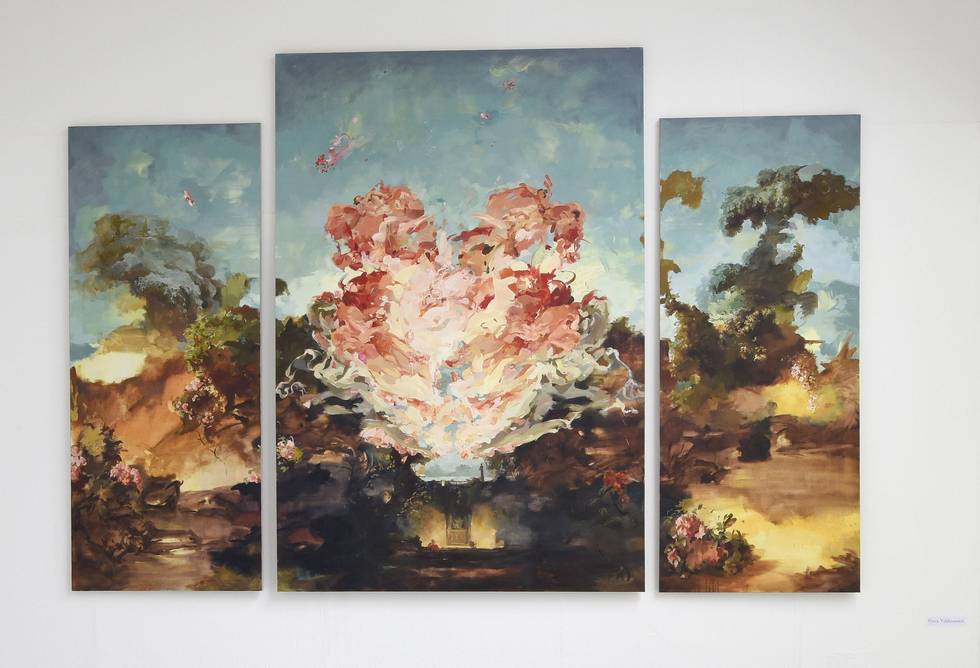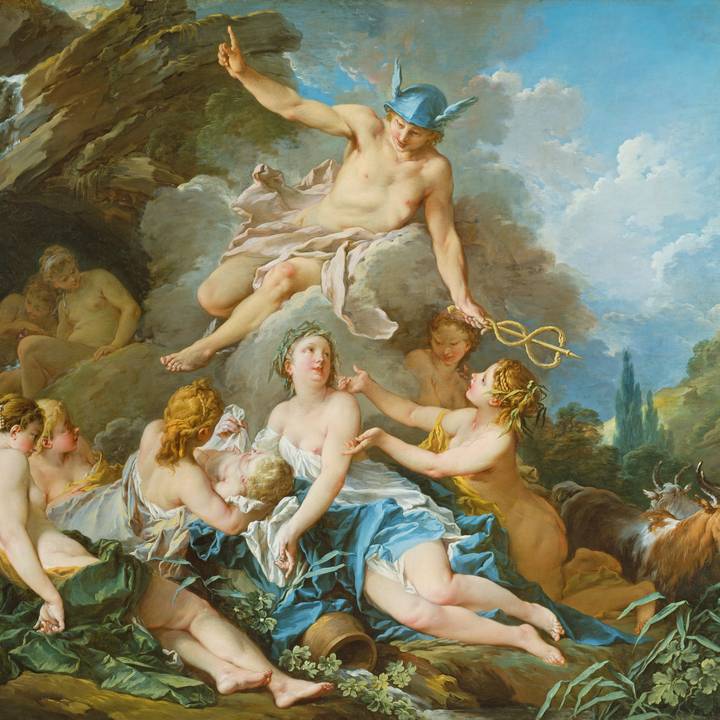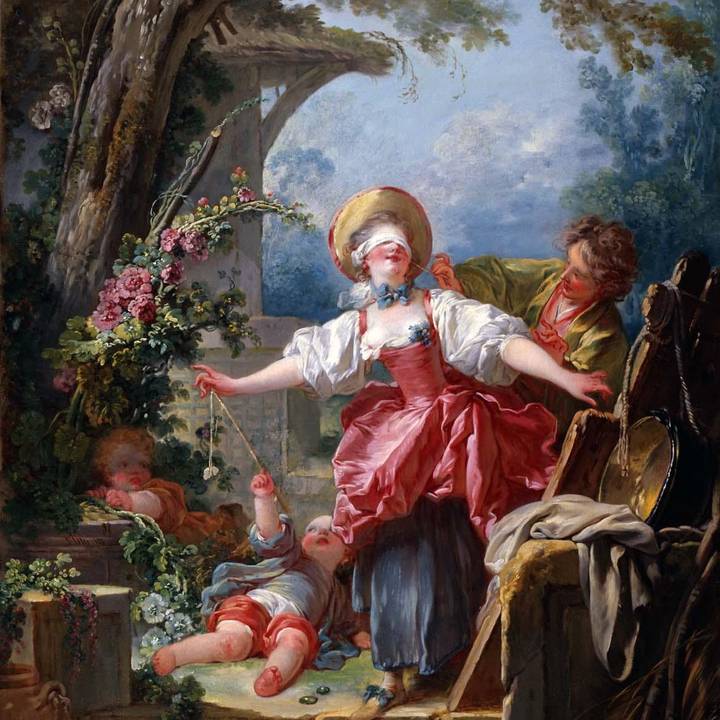Rococo art has been in and out of favor many times since it originated in the eighteenth century. At various points over the past two hundred and fifty years or so, this elegant and graceful style of art, design, fashion (and more) has been forgotten, and remembered, reinvented and reviled, celebrated and ridiculed almost in equal measures.
Characterized by delicate curvilinear forms, shells and floral patterns, it began as the preferred aesthetic mode of wealthy elites in France at the end of the reign of Louis XIV, and is famously associated with Madame de Pompadour, mistress of the Louis XV.
Some of the Wallace Collection’s most incomparable Rococo paintings belonged to Pompadour. Her portrait can be seen there in a work painted by François Boucher (1703-1770), her favorite painter. He depicted her in a lush garden wearing an elegant gown in her favorite color of pink.
In the 1860s, one of the historical moments when the Rococo was being remembered and revived, the 4th Marquess of Hertford acquired this portrait for his collection of what is now the world’s preeminent assemblage of Rococo paintings.
Despite, or perhaps because of, the predominance of Rococo painting in the eighteenth-century, critics of the time with moral and political agendas inveighed against its “agreeable vices”: its aesthetic of excess, sensuality, pleasure and its love of artifice and pretty colors.
Modernist critics echo many of these complaints. They have derided Rococo art as frivolous, decadent, not serious, over-voluptuous, insufficiently rectilinear, obsessed with surface, or too colorful (often that has meant too much pink); as kitschy, tacky, maximalist. And above all, as “feminine” (not in a good way).
Paradoxically, it is these very qualities that have given the Rococo its remarkable staying power, and made it a key source of inspiration for some of the most influential artists working today.
The animating possibilities of the Rococo have been productively felt in the work of feminist, queer and dissenting artists from a number of modern traditions, including Florine Stettheimer, Andy Warhol, Cindy Sherman and Yinka Shonibare, as well as younger generations of artists such as Nicolas Party, Yvette Mayorga, Fabiola Jean-Louis. And Flora Yukhnovich (1990), who has been spectacularly successful in her painterly dialogues with the Rococo.
A pair of paintings by Yukhnovich hung in the Wallace Collection in the place usually reserved for two of Boucher’s most ambitious essays in the genre of pastoral. Her Folies Bergère and A World of Pure Imagination looked entirely at home there, but also help us to see Boucher and the language of the Rococo in terms that remind us of their relevance and resonance for our own times.
Yukhnovich’s first engagements with Rococo art focused on Jean-Honoré Fragonard (1732-1806), and The Swing (1767-68) —today one of the most famous paintings in the Wallace Collection, and probably the most iconic example of Rococo painting in existence.
The painting is archetypally Rococo in its flowery opulence, its emphasis on pink, its playful eroticism. It shows a pretty woman in a frothy pink dress sitting on a swing propelled by one man, while in the left foreground, another —her lover— is treated to a view of her legs (and more) as her skirts billow around her.
The lighthearted insouciance of the subject has led most commentators to overlook the subversive aspects of this libertine image. Its naughtiness, its irony and emphasis on pleasure pointedly contradict ideas that were widely promoted at the time by philosophers such as Jean-Jacques Rousseau, who insisted upon the signal importance of female virtue and modesty, the sanctity of love and marriage, and motherhood as a woman’s primary social role.
Fragonard’s swinging woman is actively, subversively having fun, which is meaningful in itself—ironically meaningful, because subversive meaning is usually equated with seriousness, not fun. Flora Yukhnovich understands such ironies and the subversive potential of the Rococo better than most, and has deployed them to great effect in her paintings.
Although Fragonard provided a starting point for Yukhnovich’s brilliant explorations of the Rococo, and the development of her own post-abstract, post-Rococo visual idiom, since 2017 her most sustained engagements have been with the work of Boucher, who was, not coincidentally, Fragonard’s teacher.
Though Fragonard is the more widely recognized painter today —in no small part thanks to the fame of The Swing—it was Boucher who, for much of the eighteenth century, enjoyed dazzling success (despite the haters) as the central proponent of Rococo painting.
For decades Boucher provided star attractions at the Louvre’s famous Salon exhibitions. (By contrast, Fragonard’s works were confined to the private homes of his elite patrons, and never shown publicly. The Swing, for example, was never seen outside of private collections until its exhibition in Paris in 1860.)
Boucher, along with his patron, Madame de Pompadour, came to symbolize the essence of the style itself. Nowhere was this more evident than at the Salon of 1753 where Boucher exhibited The Rising and Setting of the Sun, a pair of flamboyantly Rococo pictures commissioned by Pompadour for one of her private residences.
Both paintings feature a scantily clad Apollo standing in a swirling vortex of vaporous clouds, water and watered silks, painted in shades of aquamarine, rose and pearlescent pinks. This comely god is surrounded by various denizens of the aqueous realm, including a bevy of water nymphs, some of whom look at Apollo in all his luminous glory, and others who don’t look at him at all.
One critic of the time complained about the inattention, while also warning mothers to shield their daughters from the indecency of exposure to a nearly naked male form. Both comments can be understood as veiled criticisms directed at Pompadour for having the audacity (and immodesty) to commission such works, which belonged to the ambitious genre of history painting – conventionally the domain of male patrons, and one that assumed male viewers.
Other commentators took Boucher to task for the profusion of pink in these works, whose tonalities critics likened to the artificiality of cosmetics, especially to the rouge so beloved by eighteenth-century women, including, famously, Pompadour herself.
Such criticism laid the ground work for the abiding tendency ever after to associate Boucher’s art and the Rococo more generally, for better or for worse, with certain notions of femininity and so-called female taste – notions that are still (or again) embraced today, though not without some ambivalence.
Inspired by the exuberance, color and materiality of Rococo painting, works by Flora Yuknovich such as In the Pink (2019) and Tu me vas faire rougir (2017), demonstrate that she appreciates how the love of traditional signifiers of femininity, such as cosmetic artifice, florid ornament or pink, or just love of the Rococo itself, can be a gesture of defiance of convention or an assertion of female agency, a valorization of the feminine. Flora’s work both embraces and critiques these ideas, just as she embraces and critiques the Rococo itself.

As Boucher’s own pictures sometimes do – and sometimes don’t – her work also offers interventions into questions of who beautiful paintings are for, how they might be meaningful and what it means to look at them.
At the same time, it invites viewers to luxuriate in the delicious pleasures of color, paint, of the painterly trace and in the ineffable beauty of sibilant forms that scamper and cavort with glee. It is an art that offers the guilty pleasure of visual pleasure itself.
Flora Yukhnovich’s work represents a new “efflorescence” of the Rococo. It testifies to her full understanding of the syntax, meaning and spirit of the language of the Rococo. A look at any of paintings shows that she also speaks this language fluently, but gives it inflections that are all her own.
This article was written by Melissa Hyde, Professor of Art History at the University of Florida.



